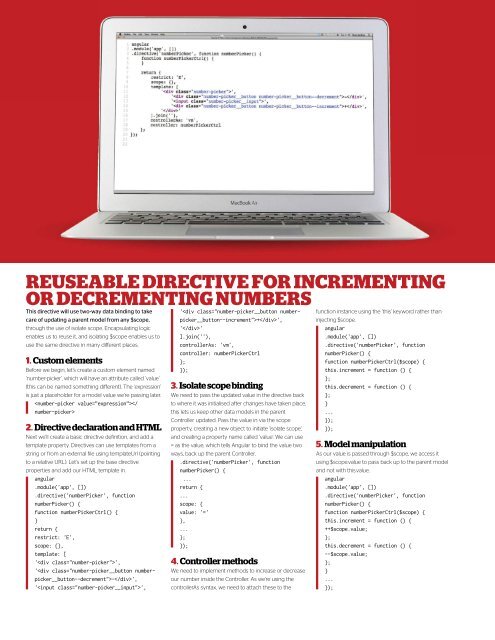Web.Designer.Advanced.Angular-P2P
Create successful ePaper yourself
Turn your PDF publications into a flip-book with our unique Google optimized e-Paper software.
REUSEABLE DIRECTIVE FOR INCREMENTING<br />
OR DECREMENTING NUMBERS<br />
This directive will use two-way data binding to take<br />
care of updating a parent model from any $scope,<br />
through the use of isolate scope. Encapsulating logic<br />
enables us to reuse it, and isolating $scope enables us to<br />
use the same directive in many different places.<br />
1. Custom elements<br />
Before we begin, let’s create a custom element named<br />
‘number-picker’, which will have an attribute called ‘value’<br />
(this can be named something different). The ‘expression’<br />
is just a placeholder for a model value we’re passing later.<br />
<br />
2. Directive declaration and HTML<br />
Next we’ll create a basic directive definition, and add a<br />
template property. Directives can use templates from a<br />
string or from an external file using templateUrl (pointing<br />
to a relative URL). Let’s set up the base directive<br />
properties and add our HTML template in.<br />
angular<br />
.module('app', [])<br />
.directive('numberPicker', function<br />
numberPicker() {<br />
function numberPickerCtrl() {<br />
}<br />
return {<br />
restrict: 'E',<br />
scope: {},<br />
template: [<br />
'',<br />
'-',<br />
'',<br />
'+',<br />
''<br />
].join(''),<br />
controllerAs: 'vm',<br />
controller: numberPickerCtrl<br />
};<br />
});<br />
3. Isolate scope binding<br />
We need to pass the updated value in the directive back<br />
to where it was initialised after changes have taken place,<br />
this lets us keep other data models in the parent<br />
Controller updated. Pass the value in via the scope<br />
property, creating a new object to initiate ‘isolate scope’,<br />
and creating a property name called ‘value’. We can use<br />
= as the value, which tells <strong>Angular</strong> to bind the value two<br />
ways, back up the parent Controller.<br />
.directive('numberPicker', function<br />
numberPicker() {<br />
...<br />
return {<br />
...<br />
scope: {<br />
value: '='<br />
},<br />
...<br />
};<br />
});<br />
4. Controller methods<br />
We need to implement methods to increase or decrease<br />
our number inside the Controller. As we’re using the<br />
controllerAs syntax, we need to attach these to the<br />
function instance using the ‘this’ keyword rather than<br />
injecting $scope.<br />
angular<br />
.module('app', [])<br />
.directive('numberPicker', function<br />
numberPicker() {<br />
function numberPickerCtrl($scope) {<br />
this.increment = function () {<br />
};<br />
this.decrement = function () {<br />
};<br />
}<br />
...<br />
});<br />
});<br />
5. Model manipulation<br />
As our value is passed through $scope, we access it<br />
using $scope.value to pass back up to the parent model<br />
and not with this.value.<br />
angular<br />
.module('app', [])<br />
.directive('numberPicker', function<br />
numberPicker() {<br />
function numberPickerCtrl($scope) {<br />
this.increment = function () {<br />
++$scope.value;<br />
};<br />
this.decrement = function () {<br />
--$scope.value;<br />
};<br />
}<br />
...<br />
});


